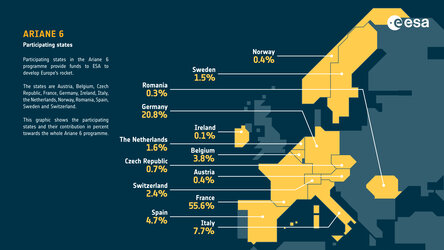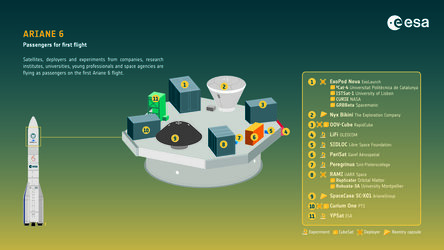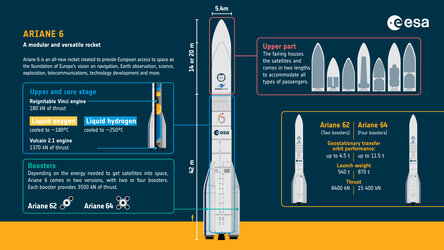

Ariane 6 who makes what infographic
Thank you for liking
You have already liked this page, you can only like it once!
An infographic showing a selection of the industrial contributors for Europe's Ariane 6 rocket.
ESA’s role in the development of Ariane 6 is to oversee the procurement process, as well as being responsible for the overall launch system, enabling Europe to realise its ambitions on the world stage. Companies across Europe are building the launch vehicle and its components, with ArianeGroup as prime contractor and design authority. The P120C booster motor – used on both Ariane 6 and Vega-C rockets – is developed by ArianeGroup and Avio. It is integrated in French Guiana by their joint venture, Europropulsion.
ArianeGroup integrates the boosters with the stage equipment. France’s space agency, CNES, oversees Europe’s Spaceport in French Guiana and is responsible for developing the Ariane 6 launch site for the new mission. Once Ariane 6 is operational, Arianespace will be the launch service provider for the rocket. It already has more than 25 launches on order. While ESA provides the requirements for institutional missions, European space companies oversee identifying commercial market requirements, as they are responsible for the commercial use of Ariane 6.
13 states are participating in the Ariane 6programme: Austria, Belgium, Czech Republic, France, Germany, Ireland, Italy, the Netherlands, Norway, Romania, Spain, Sweden and Switzerland.
Europe’s newest rocket soon launches, taking with it many space missions each with a unique objective, destination and team at home, cheering them on. Whether launching new satellites to look back and study Earth, peer out to deep space or test important new technologies in orbit, Ariane 6’s first flight will showcase the versatility and flexibility of this impressive, heavy-lift launcher.
Ariane 6 was designed with versatility in mind. The rocket comes in two versions and has a reignitiable upper stage to launch multiple satellites on a single flight, as well as missions that need a ‘heavy lift’ to the Moon and beyond. Payload carriers allow small satellites to piggyback on a launch providing cost-effective launch opportunities for small companies wanting to access the growing space industry.
Ariane 6 will launch several satellites, deployers and experiments from space agencies, companies, research institutes, universities and young professionals on its first flight.
Ariane 6 follows the hugely successful Ariane 5, Europe's principal rocket for more than a quarter century, flying 117 times between 1996 and 2023 from Europe's Spaceport in French Guiana.
-
CREDIT
ESA -
LICENCE
ESA Standard Licence

Ariane 6 infographic: participating states

Ariane 6 infographic: first passengers

Ariane 6 infographic: at a glance

Prometheus to power future launch vehicles

